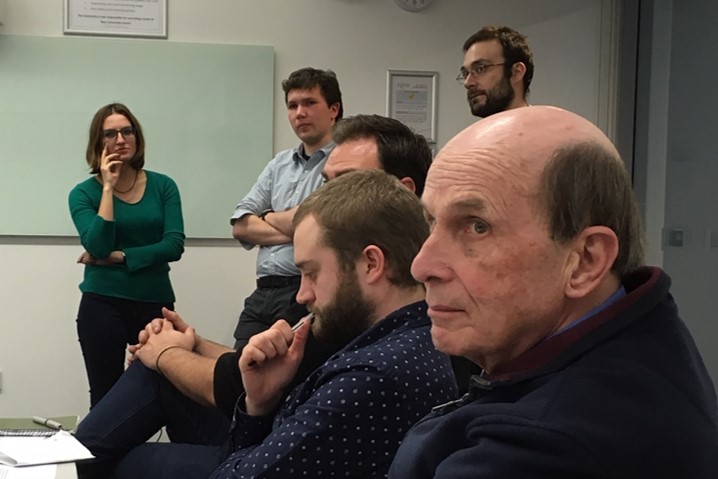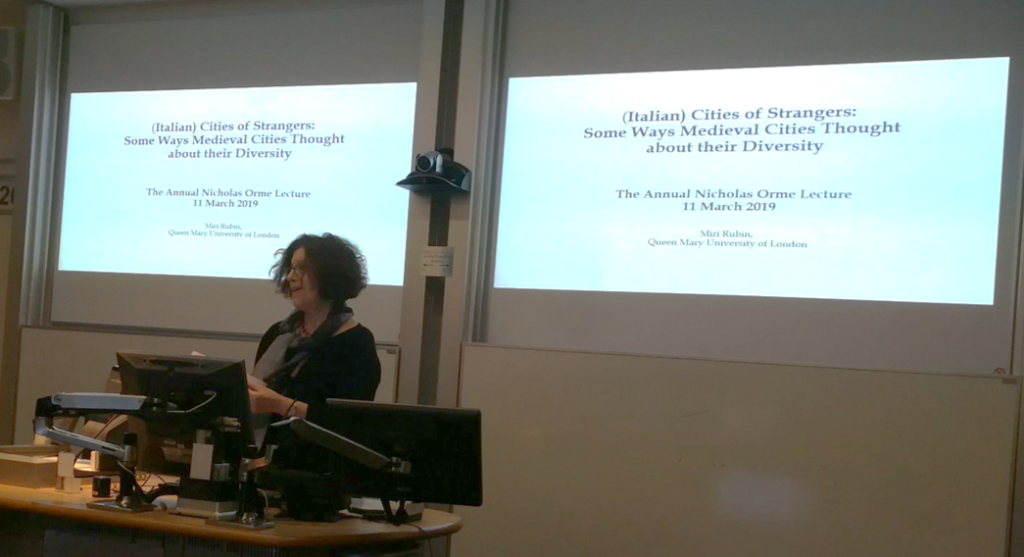
Posted by Edward Mills
20 March 2019The Centre for Medieval Studies here at Exeter is well-known for its sense of community, and for the value it places on the exchange of ideas in an informal and relaxed setting. One of the key events in our research year, the annual Orme Day, aims to achieve exactly that with a postgraduate symposium followed by the Nicholas Orme lecture, a public lecture on medieval studies by a visiting speaker. This year’s event – affectionately known as the ‘Feast of Orme’ – took place on Tuesday 12th March. After the unfortunate disruption to last year’s event caused by industrial action, we were delighted to be able to run the event in its traditional format once again.
The day began shortly after lunch, with a series of 20-minute presentations from current postgraduate students. The topics of these presentations reflected the wide range of research undertaken at the Centre. Philip Wallinder’s talk, ‘Apocryphal? Who, Me?’, examined John Trevisa‘s approach to translating the Gospel of Nicodemus into Middle English and was informed by both translation theory and the close-reading of Latin and Middle English texts. Trevisa’s concordance of several distinct calendar systems and his use of intertextuality offered fruitful topics for discussion, as Philip drew on texts from St. Jerome’s Chronicon to recent editions of the Latin Nicodemus to illustrate the relationship between the Middle English ‘Nicodemus’ and its sources.
By contrast, Ekaterina Novokhatko, a visiting PhD student and member of the HERA After Empire project, focused on more geographical questions in her presentation. She outlined her attempts to map the spread of martyrological texts (and their attendant communication networks) in eleventh-century Europe. Her talk showed how Catalonia functioned as a zone of contact, within which French interest in the life of St. Gerald met the northern Italian focus on St. Alexius; using mapping tools, she neatly illustrated how these two ‘models of the layman saint’ circulated together in the area in which a contemporary pope, Silvester II, had studied in his youth.

There was a similar saintly focus to Henry Marsh‘s talk, albeit in a less conventional sense: Henry explored the Gesta Henrici Quinti (1413-16), a text that has typically been interpreted as a paean to his namesake’s celebrated martial prowess. Henry, however, focused squarely on those readings that emphasise the almost-hagiographic elements of the text, arguing that in order to grasp the anonymous author’s full understanding of the king, it is necessary to acknowledge those readings that look beyond the commonly-cited sources of chivalric texts and to consider the Gesta as a response to challenges posed both by France and by Lollardy. The text, Henry noted, frames the King’s physical struggles as spiritual struggles, down-playing traditional ‘hack-and-slash’ romance-inspired elements and aligning the monarch, perhaps counterintuitively, with saints who had faced off against temporal power. While the Gesta might be useful for analysing myth-making, Henry suggested, it is equally important to ask precisely which myths its author was attempting to create.
Following a short break, the gaggle of medievalists reassembled in the plush surroundings of the Business School for the keynote Orme Lecture, delivered by the inimitable Miri Rubin. Prof. Rubin’s talk concerned urban societies in the Middle Ages and was entitled ‘(Italian) Cities of Strangers: Some Ways Medieval Cities Thought About Their Diversity’. As she explained, this topic was just one of many that would have paid tribute to the work of Nicholas Orme, but it was probably the most effective in allowing the assembled audience to engage with the ‘search for the human’ that has been at the heart of his research.

Over the course of her lecture, Prof. Rubin examined attitudes to ‘strangers’ and ‘foreigners’ in medieval Italy and beyond, charting how the ‘Great Transformation’ of the fourteenth century led to a shift in views on non-locals. Thinkers and legal theorists, she stressed, increasingly moved away from ‘pathways to citizenship’ and embraced a ‘rhetoric of exclusion’. Her startling final slide – showing a post-Black-Death ‘ideal’ city as one that appeared to be empty – left us all with plenty to think about. It was a talk that talk invited comparisons with contemporary attitudes towards immigration and integration, and stressed the complex relationship between medieval and modern attitudes to the ‘other’.
It certainly was a fascinating and stimulating day for all involved, and a reminder of the vitality and vision that characterise the Centre for Medieval Studies’ research community. The Centre would like to thank all of those involved in planning, organising and contributing to the event, from postgraduates to our keynote speaker; in particular, however, we would like to show our appreciation for Nicholas Orme, whose generous funding of the lecture series allows us to invite many of the leading lights of contemporary medieval studies to challenge, inspire, and invigorate us all.